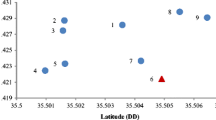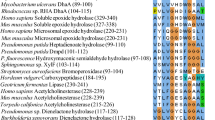Abstract
Aromatic ring hydroxylating dioxygenases (ARHDs), harboured by a variety of bacteria, catalyze the initial reaction in the degradation of a wide range of toxic environmental contaminants like aromatic and polycyclic aromatic hydrocarbons (PAHs). Regardless of the source, bacteria harbouring RHDs play major role in the removal of these toxic contaminants. The diversity of ARHDs in contaminated sites is supposed to be huge. However, most of the ARHD diversity studies are based on the PAH degraders and the ARHD diversity in the monoaromatic hydrocarbon degraders has not fully explored yet. In this study, therefore, the ARHD gene from nine different genara of the monoaromatic hydrocarbon degraders including Raoultella, Stenotrophomons, Staphylococcus, Acinetobacter, Pseudomonas, Serratia, Comamonas, Pantoea, and Micrococcus was analysed through polymerase chain reactions and sequencing. The sequence alignments of the ARHD amplicons with 81%–99% homologies were found to be highly related and held by divergent evolution from a common ancestor.



Similar content being viewed by others
References
Baldwin BR, Nakatsu CH, Nies L (2003) Detection and enumeration of aromatic oxygenase genes by multiplex and real-time PCR. Appl Environ Microbiol 69(6):3350–3358
Baun A, Sorensen SN, Rasmussen RF, Hartmann NB, Koch CB (2008) Toxicity and bioaccumulation of xenobiotic organic compounds in the presence of aqueous suspensions of aggregates of nano-C-60. Aquat Toxicol 86:379–387
Benson DA, Karsch-Mizrachi I, Lipman DJ, Ostell J, Rapp BA, Wheeler DL (2002) GenBank. Nucl Acids Res 30:17–20
Boyd DR, Bugg TDH (2006) Arene cis-dihydrodiol formation: from biology to application. Org Biomol Chem. https://doi.org/10.1039/b513226f
Boyd DR, Sharma ND, Modyanova LV, Carroll JG, Malone JF, Allen CCR, Hamilton JTG, Gibson DT, Parales RE, Dalton H (2002) Dioxygenase-catalyzed cis-dihydroxylation of pyridine-ring systems. Can J Chem 80:589–600
Butler CS, Mason JR (1997) Structure–function analysis of the bacterial aromatic ring-hydroxylating dioxygenases. Adv Microb Physiol 38:47–84
Cho O, Choi KY, Zylstra GJ, Kim YS, Kim SK, Lee JH, Sohn HY, Kwon GS, Kim YM, Kim E (2005) Catabolic role of a three-component salicylate oxygenase from Sphingomonas yanoikuyae B1 in polycyclic aromatic hydrocarbon degradation. Biochem Biophys Res Commun 327:656–662
Demaneche S, Meyer C, Micoud J, Louwagie M, Willison JC, Jouanneau Y (2004) Identification and functional analysis of two aromatic ring-hydroxylating dioxygenases from a Sphingomonas strain that degrades various polycyclic aromatic hydrocarbons. Appl Environ Microbiol 70:6714–6725
Diaz E, Ferrandez A, Prieto MA, Garcia JL (2001) Biodegradation of aromatic compounds by Escherichia coli. Microbial Mol Bioi Rev 65:523–569
Dunbar J, White S, Forney LJ (1997) Genetic diversity through the looking glass: effect of enrichment bias. Appl Environ Microbiol 63:1326–1331
Gibson DT, Parales RE (2000) Aromatic hydrocarbon dioxygenases in environmental biotechnology. Curr Opin Biotechnol 11:236243
Hendrickx B, Junca H, Vosahlova J, Lindner A, Ruegg I et al (2006) Alternative primer sets for PCR detection of genotypes involved in bacterial aerobic BTEX degradation: distribution of the genes in BTEX degrading isolates and in subsurface soils of a BTEX contaminated industrial site. J Microbiol Methods 64:250–265
Hurtubise Y, Barriault D, Sylvestre M (1996) Characterization of active recombinant His-tagged oxygenase component of Comamonas testosteroni B-356 biphenyl dioxygenase. J Biol Chem 271:8152–8156
Iwai S, Johnson TA, Chai B, Hashsham SA, Tiedje JM (2011) Comparison of the specificities and efficacies of primers for aromatic dioxygenase gene analysis of environmental samples. Appl Environ Microbiol 77:3551–3557
Jiang H, Parales RE, Gibson DT (1999) The αsubunit of toluene dioxygenase from Pseudomonas putida F1 can accept electrons from reduced ferredoxinTOL but is catalytically inactive in the absence of the β subunit. Appl Environ Microbiol 65:315–318
Kauppi B, Lee K, Carredano E, Parales RE, Gibson DT, Eklund H, Ramaswamy S (1998) Structure of an aromatic ring-hydroxylating dioxygenase-naphthalene 1,2-dioxygenase. Structure 6:571–586
Kivisaar M (2009) Degradation of nitroaromatic compounds: a model to study evolution of metabolic pathways. Mol Microbiol 74:777–781
Lozada M, Riva Mercadal JP, Guerrero LD, Di Marzio WD, Ferrero MA, Dionisi HM (2008) Novel aromatic ring-hydroxylating dioxygenase genes from coastal marine sediments of Patagonia. BMC Microbiol 8:50
Maeda T, Takahashi Y, Suenaga H, Suyama A, Goto M, Furukawa K (2001) Functional analyses of Bph-Tod hybrid dioxygenase which exhibits high degradation activity toward trichloroethylene. J Biol Chem 276:29833–29838
Maniatis T, Fritsch EF, Sambrook J (1982) Molecular cloning a laboratory manual. Cold Spring Harbor Laboratory, Cold Springs Harbor, NY
Nam JW, Nojiri H, Yoshida T, Habe H, Yamane H, Omori T (2001) New classification for oxygenase components involved in ring-hydroxylating oxygenations. Biosci Biotechnol Biochem 65:254–263
Padda RS, Wang C, Hughes JB, Kutty R, Bennett GN (2003) Mutagenicity of nitroaromatic degradation compounds. Environ Toxicol Chern 22:2293–2297
Parales RE, Resnick SM, (2006) Aromatic ring hydroxylating dioxygenase. In: Ramos JL, Levesque RC (eds) Pseudomonas. Springer, Netherlands, pp 287–340
Peng AS, Xiong Y, Xue XY, Fu F, Gao W, Zhao YS, Tian QH (2010) A profile of ring-hydroxylating oxygenases that degrade aromatic pollutants. Rev Environ Contam Toxicol 206:65–94
Resnick SM, Lee K, Gibson DT (1996) Diverse reactions catalyzed by naphthalene dioxygenase from Pseudomonas sp. strain NCIB 9816. J Ind Microbiol 17:438–457
Ricco G, Tomei MC, Ramadori R, Laera G (2004) Toxicity assessment of common xenobiotic compounds on municipal activated sludge: comparison between respirometry and Microtox (R). Water Res 38:2103–2110
Seo JS, Keum YS, Li QX (2009) Bacterial degradation of aromatic compounds. Int J Environ Res Public Health 6:278–309
Shigematsu T, Yumihara K, Ueda Y, Numaguchi M, Morimura S, Kida K (2003) Delftia tsuruhatensis sp. nov., a terephthalate-assimilating bacterium isolated from activated sludge. Int J Syst Evol Microbiol 53:1479–1483
Sousa STP, Cabral L, Júnior L, Vieira G, Oliveira VM (2017) Diversity of aromatic hydroxylating dioxygenase genes in mangrove microbiome and their biogeographic patterns across global sites. MicrobiologyOpen 6:1–13
Tan HM, Tang HY, Joannou CJ, Abdel-Wahab NH, Mason JR (1993) The Pseudomonas putida ML2 plasmid-encoded genes for benzene dioxygenase are unusual in codon usage and low in GC content. Gene 130:33–39
van der Meer JR, de Vos WM, Harayama S, Zehnder AJ (1992) Molecular mechanisms of genetic adaptation to xenobiotic compounds. Microbial Rev 56:677–694
Vanbroekhoven K, Ryngaert A, Bastiaens L, Wattiau P, Vancanneyt M, Swings JW, De Mot R, Springael D (2004) Streptomycin as a selective agent to facilitate recovery and isolation of introduced and indigenous Sphingomonas from environmental samples. Environ Microbiol 6:1123–1136
Wackett LP, Gibson DT (1988) Degradation of trichloroethylene by toluene dioxygenase in whole-cell studies with Pseudomonas putida F1. Appl Environ Microbiol 54:1703–1708
Werlen C, Kohler HP, van der Meer JR (1996) The broad substrate chlorobenzene dioxygenase and cis-chlorobenzene dihydrodiol dehydrogenase of Pseudomonas sp. strain P51 are linked evolutionarily to the enzymes for benzene and toluene degradation. J Biol Chem 271:4009–4016
Yavas A, Icgen B (2018) New aerobic bacterial degraders with their relative pathways discovered for efficient removal of individual BTEX compounds. Submitted to CLEAN-Soil Air Water
Zhong Q, Zhang H, Bai W, Li M, Li B, Qiu X (2007) Degradation of aromatic compounds and degradative pathway of 4-nitrocatechol by Ochrobactrum sp. B2. J Environ Sci Health A Tox Hazard Subst Environ Eng 42:2111–2116
Ziagova MG, Liakopoulou-Kyriakides M (2010) Comparative studies on the degradation of three aromatic compounds by Pseudomonas sp. and Staphylococcus xylosus. J Environ Sci Health A Tox Hazard Subst Environ Eng 45:1017–1025
Zylstra GJ, Gibson DT (1989) Toluene degradation by Pseudomonas putida F1: nucleotide sequence of the todC1C2BADE genes and their expression in E. coli. J Biol Chem 264:14940–14946
Acknowledgements
The authors would like to thank Middle East Technical University Research Fund for the financial support through the projects BAP-03-11-2016-001.
Author information
Authors and Affiliations
Corresponding author
Rights and permissions
About this article
Cite this article
Yavas, A., Icgen, B. Diversity of the Aromatic-Ring-Hydroxylating Dioxygenases in the Monoaromatic Hydrocarbon Degraders Held by a Common Ancestor. Bull Environ Contam Toxicol 101, 410–416 (2018). https://doi.org/10.1007/s00128-018-2350-4
Received:
Accepted:
Published:
Issue Date:
DOI: https://doi.org/10.1007/s00128-018-2350-4




